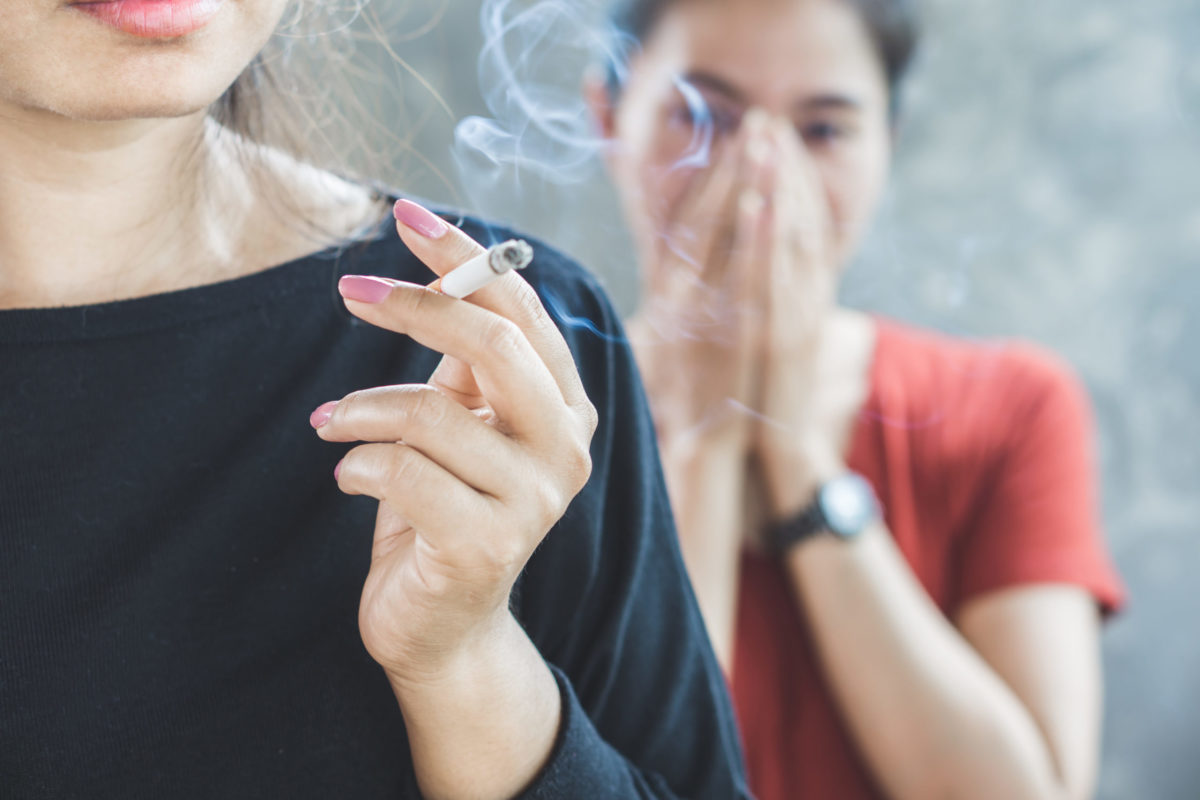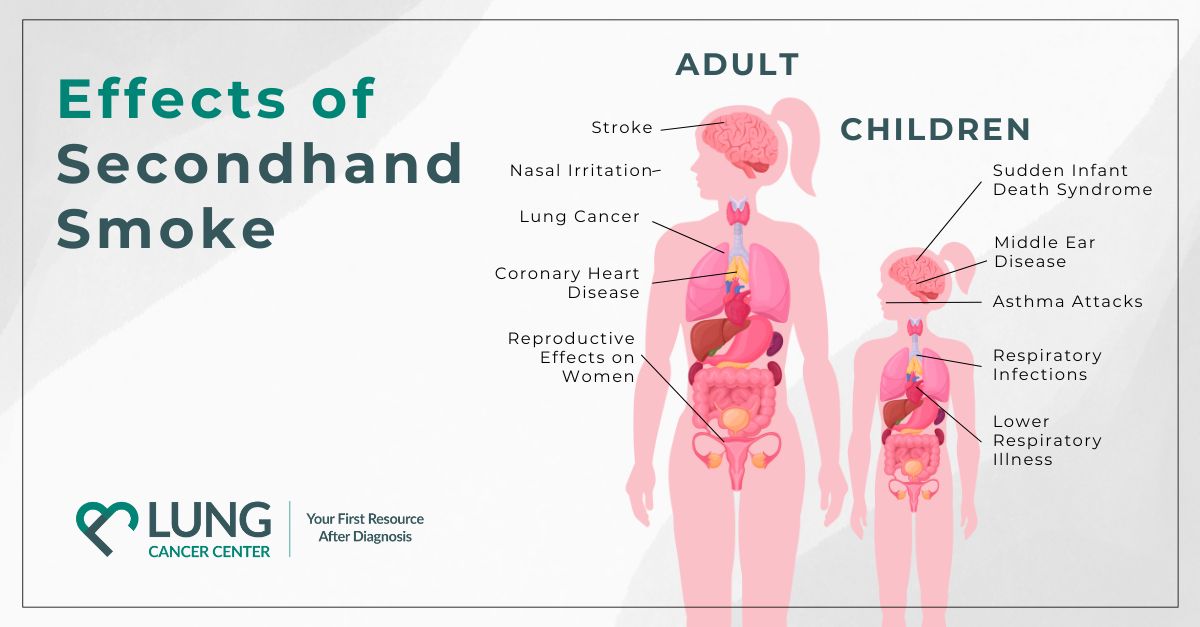How to Navigate Secondhand Smoke Living with a Smoker
By Madeline May |
It is known that secondhand smoke harms those around a smoker. However, many people are still affected by secondhand smoke. How should someone navigate the trickiness associated with living with a smoker?


5 Tips for Non-Smokers to Avoid Secondhand Smoke
For those dealing with lung cancer or mesothelioma, secondhand smoke can be nearly as dangerous as smoking itself because it contains over 7,000 harmful chemicals. Research indicates that lung cancer patients with a history of secondhand smoke exposure could worsen their prognosis. If you are suffering from a lung disease such as mesothelioma, living with a smoker can make it extremely difficult to avoid secondhand smoke. These people usually experience reduced overall survival rates and lower progression-free survival, leading to higher mortality rates. This specific smoke consists of two types:
- Sidestream smoke: Smoke emitted directly from a burning cigarette or cigar.
- Mainstream smoke: Smoke exhaled by a smoker.
With over 480,000 smoking-related deaths annually, including those linked to secondhand smoke, it is crucial for non-smokers, particularly lung cancer and mesothelioma patients, to avoid secondhand smoke. To help you navigate living with an asbestos-exposed smoker, and to protect yourself from secondhand smoke, the Lung Cancer Center has compiled these five helpful tips to help you have difficult conversations about secondhand smoke exposure and encourage your loved one to quit smoking.
Tip 1: Recognize Your Mental Health
Dealing with a lung cancer diagnosis can be stressful to navigate, and living with a smoker can cause an extra stressful strain on your relationship with your loved one. A stressed relationship can be challenging to navigate and can negatively impact both parties’ mental health. Additionally, inhaling secondhand smoke is associated with an increase in symptoms of depression and suicidal thoughts among adults.
If you notice you are experiencing these emotional feelings, expressing them to the smoker in your life is an important step in not only your relationship with them but also in maintaining your health. When having this difficult discussion, there are a few things to keep in mind:
- Be polite
- Be non-confrontational
- Be respectful
- Be non-judgmental
Tip 2: Set Boundaries for Treatment
Effective communication is the key to setting boundaries with the smoker in your life. Effective communication builds better relationships and leaves both parties feeling satisfied and accomplished. It’s important to remember that your loved one is also having a difficult time processing your, or their own, lung cancer diagnosis.
If conflict does arise while you are having a difficult conversation about smoking, be respectful and explain to your loved one the consequences of their smoking, and how it may have physical and mental effects. Offer compromises throughout the conversation and keep an open mind to your loved ones’ proposed ideas. Some ways to avoid secondhand smoke and set boundaries with your loved one are:
- Designate smoking zones and smoke-free zones.
- Do not allow them to smoke in the car.
- Talk to them about the effects smoking will have on your lung cancer treatments.
- Mention the benefits of quitting and encourage them to seek help.
Tip 3: Don’t Allow Secondhand Smoke Indoors
Compared to the outside, the inside of your house has limited ventilation. Opening windows could help curb the effects of secondhand smoke, but ideally, your home should be smoke-free. Suggest designated outdoor smoking areas to minimize smoke transfer and talk to your smoker about your concerns about the effects of smoking inside, especially focusing on its impact on your health. Even for healthy individuals, the long-term effects of secondhand smoke are obvious, but for those exposed to asbestos, it can have a significant impact on their health. We suggest starting slow, having multiple conversations instead of one, negotiating fair boundaries, and prioritizing your health.
- Start with a conversation: Talk to the smoker about your concerns. Explain the dangers of secondhand smoke, especially for your health, and focus on its effects on you.
- Negotiate Boundaries: Ideally, your home should be smoke-free. Suggest designated outdoor smoking areas and rules to minimize smoke transfer. If you live in an apartment, check your lease for smoking restrictions.
- Prioritize Your Health: Ultimately, your health comes first. If necessary, spend more time in smoke-free environments outside the home. For additional support, contact the American Lung Association for resources on navigating secondhand smoke exposure.
Tip 4: Be Cautious of Secondhand Smoke on Clothes
Smoke can adhere to surfaces indoors and may stick to your clothes even if you are not around them. Smoke residue on surfaces is not visible to the naked eye, so it’s important to wash your clothes and linens frequently to remove odors and settled smoke. If they continue to smell after washing them, try hang-drying your clothes outside, as it can usually eliminate the odor. While the exact risk of secondhand smoke on clothes is still being studied, tiny particles on clothes can be inhaled directly or transferred to other surfaces you touch.
Even if your loved one smokes outside, they can bring smoke indoors on their clothes. Asking your loved one to wear a designated “smoking jacket” or sweatshirt outside can reduce the risk of the smokey layer on their clothes coming into close contact with you. Your loved one can also take extra precautions by washing their hands and face after smoking to avoid spreading particles. For those suffering from asbestos-related diseases such as mesothelioma and lung cancer, it’s wise to minimize exposure to help reduce your risk of complicating your lung cancer diagnosis.
Tip 5: Encourage to Stop Smoking
Aside from reducing your chances of developing lung-related diseases, quitting smoking can have many benefits to you and your loved ones’ health. Some tips that can help you quit smoking include, setting a date to quit when stress is low, exercising, practicing mental health relaxation, surrounding yourself with support, and avoiding cigarette alternatives like vaping or e-cigarettes. Smoking cessation can have instant side effects on the smoker’s health. Side effects can range from feeling irritable or upset to gaining weight and having trouble sleeping.
On the other hand, some benefits your loved one will experience from quitting smoking are:
- 1 month after quitting smoking: Coughing and shortness of breath decrease.
- 3-9 months after quitting smoking: Lung function increases by 10%.
- 6 months after quitting smoking: Some notice they have a better grasp on handling stressful events.
- 1 year after quitting smoking: The risk of coronary diseases drops to half that of a smoker.
- 10 years after quitting smoking: The risk of dying from lung cancer is about half that of a smoker.
- 15 years after quitting smoking: The risk of coronary disease is the same as a non-smoker.
- 5 to 15 years after quitting smoking: The risk of having a stroke is the same as a non-smoker.
What to Do if You’ve Been Exposed to Secondhand Smoke
Living with lung cancer or mesothelioma is challenging to navigate on its own, and secondhand smoke exposure only adds to the difficult journey. We hope you will find peace and comfort at home after implementing some or all of these tips. Our patient advocates and legal advisors at Lung Cancer Center understand the complexities of lung cancer and mesothelioma and the challenges the disease brings with it. If you’re worried about your exposure and wonder what your potential legal options are, we can put you in touch with our legal advocacy team. They specialize in the intricacies of the legal system and can offer personalized advice tailored to your situation. Don’t hesitate to reach out today, as no one should go through the battle of a cancer diagnosis alone.